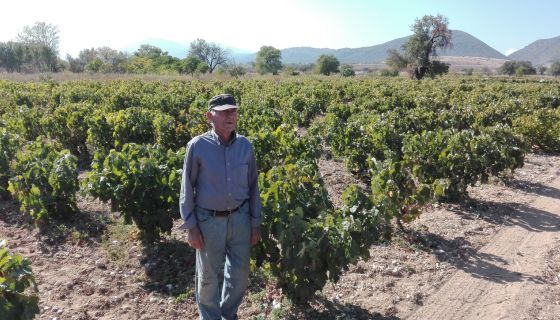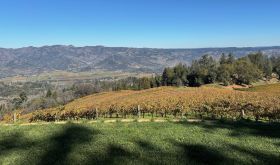My involvement in viticulture has given me the opportunity to discover new and old vineyards, and meet with new and old people.
The oldest grape grower I’ve ever met must be Mr Toutousanis from Xino Nero, a village near Amyndeon, which is in the heart of one of Greece’s most important appellations in northwest Macedonia where winemaking, dates back to antiquity.
Xino nero means ‘sour water’ in Greek, and the namesake hamlet is famous for its natural springs of acid-carbonic, calcium-rich natural mineral water with alleged curative properties for a long life, known to Aristotle and this land’s ancient king, Alexander the Great.
Here, vines were traditionally trained freestanding in the shape of a cup and, luckily, several of these monumental gobelet-pruned plants have survived. They were spared, firstly, thanks to the area’s sandy soils that proved inhospitable to the devastating phylloxera louse and, secondly, because their custodians kept the grapes mainly for their personal use and saw no need to uproot or prune them over to a Royat system for a more commercially viable crop management.
It’s for these reasons and thanks to a lead by †Nikos Kontosoros, a famous chef in the village, that I decided to look up grape grower Toutousanis.
My first meeting with him occurred when I was trying to find old vines in Xino Nero as a source for the red wine Kali Riza (Good Root) produced by the Kir-Yianni winery and exclusively made from Xinomavro grapes from the Amyndeon PDO from vines that have to be at least 40 years old.
Since Mr Toutousanis doesn’t have a cell phone, arrangements were made to meet up at his vineyard. And, what an unexpected sight that was!
The block of merely 0.4 Ha is planted to mature gnarled-trunked vines of which every single one is in excellent health and shaped in a magnificent goblet. The soil is light holding a few pebbles, typical of this sub-region called Poiro, which is a word for spring or fountain in the local dialect.
Toutousanis was leaning over a vine to remove some shoots with his chekme, an old vine-cutting tool of the early 20th century. Not to startle him, I called to him from far, but he didn’t react, being hard of hearing. When one sense diminishes another is often amplified and, lo and behold, as soon as I approached him he intuitively turned his head and smiled.
Though we had never met before, he greeted me with eyes that lit up with the joy and enthusiasm of a little child. You see: it’s not common for him to be visited by someone in the vineyard, especially not by a young man like me.
We introduced ourselves albeit with difficulty. Soon my urge to shout to make myself understood was lowered by the calmness of his age, and we settled on a mutually agreeable volume to start discussing the vineyard. I explained we were interested in buying his grapes provided they fit the winery’s specifications. The old man’s joy grew. And, when done praising me, he assured me that his crop “tastes just like honey”, as the local farmers’ saying for well-ripened grapes goes.
That’s what Toutousanis told me and he wasn’t wrong.
As we strolled through the vineyard, I saw normal to small-sized grape bunches, sparsely distributed per vine, with regular-sized berries that were coloured a little unevenly, which is typical for Xinomavro of Amyndeon, yet much more concentrated.
Here and there one would spot also white, pink and other red grape varieties that did not look like Xinomavro. Mr Toutousanis gave me their local names such as Amyntiótiko, Glamázda, Séfka, Chimoniátiko, and so on.
In the past, the vineyards of the area were planted mainly to wine grapes of the Xinomavro variety, which in the local dialect is called Popólka. However, it would get interplanted with table grapes because the rural economy of the region imposed their cultivation for the bartering for produce from nearby villages that were famous for their beans, peppers, potatoes and cheeses.
At the end of our walk, I asked him about the age of the vineyard, which is perhaps the most important criterion when sourcing grapes that are going to be used for the making of Kir-Yianni’s particular wine.
The answer was magical: “I’m probably 90 years old, and the vines were planted by my father about 15 to 20 years before I was born. You figure it out.” Toutousanis said.
Like a time machine, my mind replayed the past 33 years of my own juvenile existence and then pressed fast rewind to try and imagine the times this vineyard has lived through.
110 years of life!
It has survived since the Ottoman Empire and through the liberation of the area by the Greeks during the Balkan Wars, the First World War and the epoch of the Entente army of mainly French soldiers who stayed in the village school-cum-hospital, the occupation of Greece during World War II, the times of the Greek Civil War, and during many other trials.
Year in, year out, the vines put up with the markings of different generations, people wounding them with pruning shears and plough horses grazing their trunks with horseshoes. The grapes of these vines raised children and sustained families. Their fruit was presented as gifts to the elderly who wished for nothing more than to savour, one last time, the tastes and scents of their youth.
When my mind was done spinning, one final question remained unanswered. How had Mr Toutousanis managed to maintain his vineyard all these years in immaculate condition?
As I was getting ready to leave, I proposed to give the nonagenarian grower a lift back to the village one kilometre’s drive away from the vineyard. But the man politely declined: he wanted to walk as he had done in the morning. With a dose of overstated politeness, keen to better my karma by doing a good deed, I insisted. Toutousanis remained adamant.
On my return, I stopped at the restaurant of Kontosoros. I told my chef-friend what had happened though he probably already knew. I was dumbfounded by Nikos’ response that Mr Toutousanis’ way has been as unfailing as spring follows winter ever since the day he lost his beloved wife and his children moved out to nearby towns. Without fail, he gets up in the morning, sets off to the vineyard and walks back late at noon.
So here’s the key. Routine, love and purpose: that’s the secret to longevity. Everything else just feeds our selfishness, vanity and pocket.
The vine goes through the same cycle, again and again. Each year, as it adapts to its environment, it grows and takes another steady step forward. Not bothered by much else than the weather, it’s ready to give up its fruits to the earth so that it can live on through its offspring.
All along, its caretaker follows faithfully, patiently without hurrying, because he knows that as man comes to this world so he will depart one day. The vine, though, will surpass him as long as it finds a hand like his to caress the trunk and leaves as he has done for so many years.
My final thoughts return to Mr Toutousanis. The 90-year-old grape grower grew up in this vineyard, and will probably pass away in it – in a serene and beautiful send-off act that any actor dreams of playing when exiting the stage for good.
Weeks later, we picked the grapes and he came to the winery for the weighing of the crop. It was a day I will never forget. Together we went down to the wine cellar to taste older vintages of the same red wine the grapes from his old vines were intended for. As I filled his glass, I saw the most unpretentious joy in his face. The old man looked at it in the light and tried it. He did not swirl the glass ostentatiously; he did not spit after putting the wine in his mouth. Instead, Toutousanis swallowed and became overwhelmed by the pleasure, confident that his brood would receive the care it deserves.
Photos are provided by Vasilis Mylonas.















